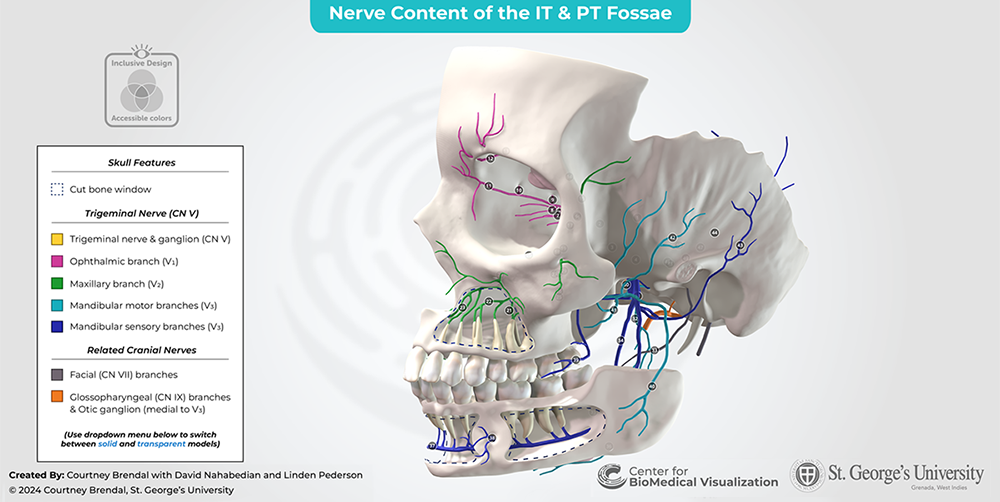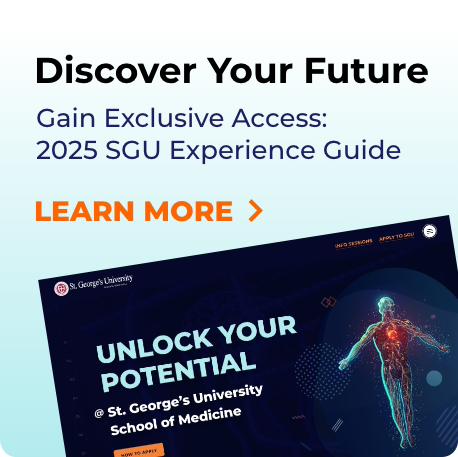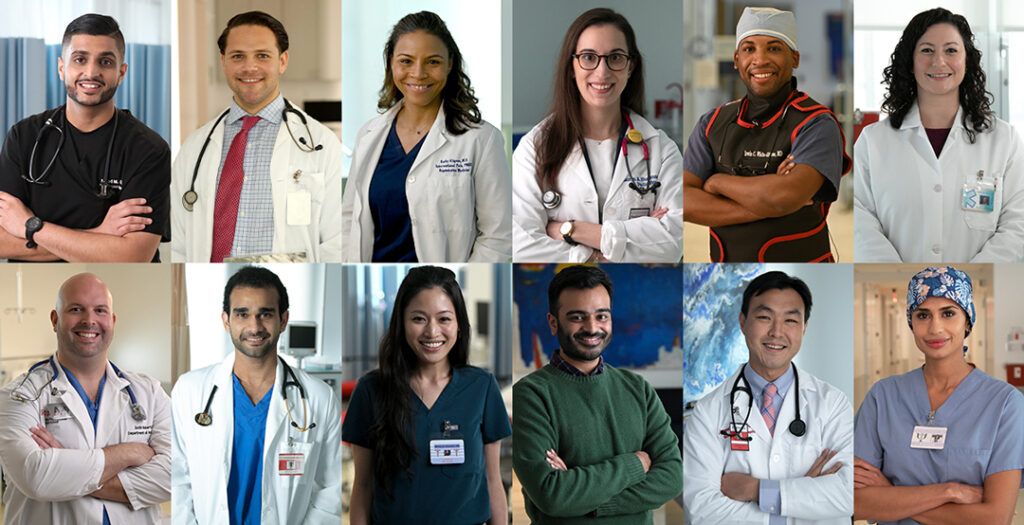As you begin your journey to becoming a doctor, choosing the right medical school is a crucial first step, yet far from a simple one. Your goals, learning style, and of course finances, all are significant factors. Determining your desired living environment for the next several years is also key. So as you assess the value of a St. George’s University (SGU) School of Medicine (SOM) education, consider the totality of the SGU experience.
The SGU model is a comprehensive, hands-on curriculum that equips you for the realities of medical practice. Our experiential curriculum is just what it sounds like; to truly “learn” theory, you must apply your knowledge through labs, simulations, and actual clinical experiences. From there, we take a holistic approach with the integration of spiraled learning, anatomy, visualization, and study abroad opportunities. We refer to it as outcome-driven: This layered, real-world approach helps students build confidence and competence for residency and beyond.
SGU is located in the Caribbean on the Island of Grenada, with clinical training sites around the globe. On campus, which, like the curriculum, is student-inspired, you’ll find cozy cafes, a dog park, tiki bar, an expansive fitness center, multi-faith prayer area, a stocked bookstore, and much more.
Let’s dial in on the core facets of an SGU education:
A student-built curriculum
We like our students to think of learning as climbing a spiral staircase. Each step you take, you revisit the same views but from a higher, more insightful perspective.
Systems-based learning
Along this path, you will build a foundation for your medical career. “We have a system whereby you learn in stages and layer that knowledge,” says Dr. Mark Clunes, interim provost and vice president of Academic Affairs, senior associate dean of Basic Sciences for School of Medicine. “That means in the first year we go through all the basics and foundational principles which are key to master and understand before you get to advanced topics. That second spiral, which means we go through the systems again, we layer more knowledge.”
Think of it like leveling up in a game—you build on what you already know, adding new skills and knowledge as you progress. You encounter important topics again and again, each time exploring them deeper, making the complex clear, and finding new connections. Mastering, layering, and then repeating that cycle while continuing to improve, learn, and evolve along the way; that’s the spiral staircase model.
“The more experience you gain, the more you will encounter some topics and the more familiar they will become,” Dr. Clunes says. “The difference is, each time you will explore them deeper, making the complex clear, and finding new connections.”
SGU offers three different tracks for its Doctor of Medicine (MD) program:
- Traditional 4-Year MD Program
- 5-Year MD Track (for students with advanced secondary school education)
- 6-Year MD Track and 7-Year MD Track (for students entering from high school or with fewer pre-medical prerequisites)
Visual and tactile learning
Visual and tactile learning is at the core of an SGU education and integrated into nearly all aspects of the medical program.
Tailored medical illustrations

Medical students often learn best in scenarios where they can tangibly see and physically engage, so the Center for BioMedical Visualization was purposefully designed for those reasons. The Center elevates the learning experience of SGU students through visual content, creating learning materials that condense large amounts of complex information into clear, easy-to-understand illustrations, animations, and models.
The Center’s learning materials provide many benefits. As medicine and technology evolve, SGU students can gain an edge by learning through tools like:
- 2D and 3D animations explaining biological processes
- Interactive learning modules and virtual anatomy tools
- Dissection and instruction in both undergraduate and graduate anatomy labs
These are just a few examples of materials that make the curriculum interactive, intuitive, and memorable. It is a resource that builds the clinical confidence needed for real-world success in the medical field.
Anatomy lab
In the SGU anatomy lab, students work with human cadavers to begin identifying structures. The curriculum also integrates traditional cadaveric dissection with modern 3D anatomical modeling, a blend that helps students visualize the human body in a holistic way while reinforcing knowledge through their hands-on interaction. Student response has reinforced the value of the anatomy lab.
“Originally, I was very bad at anatomy, and I didn’t know how to study for it. However, once I entered the lab, I realized I can get hands-on experience and know where exactly each structure is,” explains SOM student Eileen Rad. “And after removal of each structure, I knew what was underneath it, so it was better for me to visualize this than to just study it in the books.”
Simulation lab
One of the critical areas where SOM students experience rigorous academic preparation is in clinical skills via the simulation lab. SGU’s simulation lab provides an opportunity for many medical students to have their first direct interaction with ill and injured patients in a safe, simulated learning environment. In this learning environment, students are exposed to the following medical simulation-based training modalities:
- Skills training using tasks trainers (e.g., IV catheter insertion)
- High-fidelity manikin training
- Standardized (simulated) patient encounters
- Computer-based or cloud-based simulation (via i-Human)
- Hybrid training with both standardized patients and manikins
Student response to the lab has been exactly what we hope for: creating memorable, real-life patient scenarios that will help our students to become confident, knowledgeable physicians.
“In Sim Lab, they can simulate what a pneumothorax should sound like,” says Niyati Patel, SOM student. “So, we would run through the entire procedure that we have in terms of patient encounter, and then when we listen to the standardized patient, or our simulated patient, we can hear decreased breath sounds, which we wouldn’t have been able to hear with a human standardized patient. The patient, or the robot, can talk back to us through a facilitator in the back.”
Study abroad opportunities
SGU’s students have unique opportunities during their Basic Science years (years one and two of med school) to enhance their educational experience through study abroad electives known as “international selectives.”
A diversity of experiences
Students can enhance their knowledge by interacting with different cultures in different healthcare systems. “International selectives offer unique experiences for future physicians in so many ways,” says David Nahabedian, SGU’s director of selectives and assistant director and senior medical illustrator at the Center for BioMedical Visualization. “Not only do you get to travel to beautiful locations such as Prague, Kenya, or Costa Rica, but you also get to see what it would be like to practice medicine there.”
Read more about SGU student experiences in Kenya and the Czech Republic on SGU News.
SGU medical school international selectives give you an opportunity to immerse yourself in different cultures and healthcare environments. Every country has a different approach to healthcare delivery, so a study abroad elective allows you to learn about these diverse systems firsthand. That includes exposure to different medical practices, new perspectives on patient care, and in the end, gaining a deeper understanding of health challenges in other countries. The interactions with patients from a variety of cultural backgrounds helps to sharpen your communication skills, expand your cultural competence, and enhance your adaptability, all essential qualities for a physician.
Immersive clinical training
After completing the basic sciences, students transition to clinical rotations at 85+ affiliated hospitals and health systems across the United States, United Kingdom, and Canada. These hands-on experiences allow students to develop essential practical skills, gain exposure to diverse healthcare systems, and prepare for residency and future medical practice.
Hands-on experiences
The primary goal of the SGU SOM is to support you through your medical education and ensure that you have the skillset and knowledge to be successful on your path to becoming a physician. Once you leave Grenada, the same attention, guidance, and support follows you to your clinical location. This comes in the form of SGU clinical faculty who:
- Are practicing doctors and oversee students onsite
- Keep in touch with students regularly during their rotations and provide academic support
- Guide students through the residency application process
Learn more about how the program helped Nadeer Mahmood, MD ’08, a pulmonologist in the Northeastern US, not only excel in his career, but find his way back to SGU as a clinical instructor.
Exposure to new specialties
During clinical rotations, you are exposed to multiple specialties for you to consider for a career in medicine. You can find new passions you may not have considered before. It is at this point in your journey to MD you begin to truly feel like a doctor.
In the third year of med school, you complete core clinical rotations in specialties like internal medicine, surgery, pediatrics, obstetrics and gynecology, and psychiatry. The fourth year is a year of your own design where you can participate in electives like cardiology, radiology, and orthopedic surgery.
Here is a collection of resources offering a depth of information and insights on clinical rotations at SGU:
- Clinical Rotations During Medical School
- Tips for Thriving During Clinical Rotations
- Answering 8 Common Questions About SGU Clinical Rotations
Value of an SGU education
A St. George’s University School of Medicine education really does serve as a launching point for your medical career, whether stateside or international. The flexible, student-built curriculum, immersive clinical training, and international partnerships and opportunities, will provide you with the skills, knowledge, experience, and confidence to thrive in your healthcare career.
As you continue your research and decision-making process, please reach out for further information. If the value of an SGU education feels right for you, apply today.


